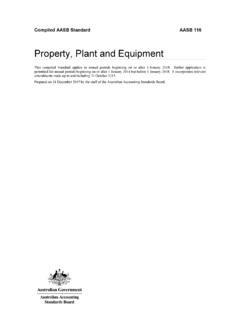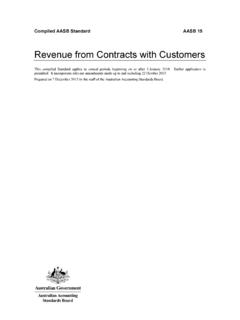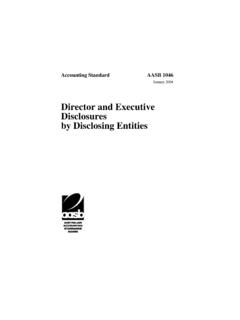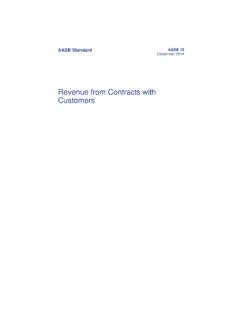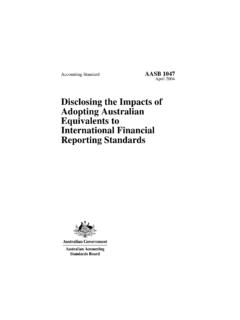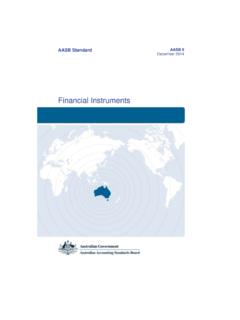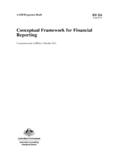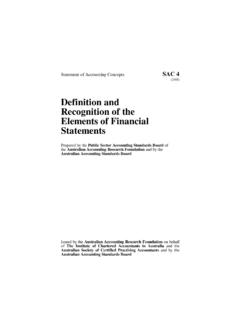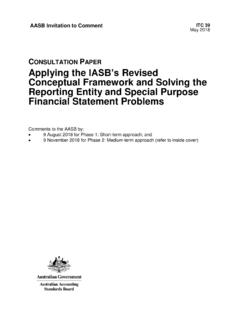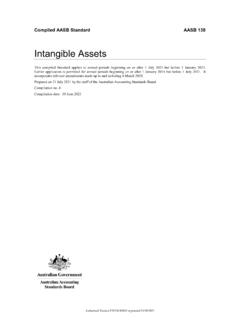Transcription of Employee Benefits - Australian Accounting Standards Board
1 compiled aasb Standard aasb 119 Employee Benefits This compiled Standard applies to annual periods beginning on or after 1 January 2020 but before 1 January 2021. Earlier application is permitted for annual periods beginning on or after 1 January 2014 but before 1 January 2020. It incorporates relevant amendments made up to and including 21 May 2019. Prepared on 2 March 2020 by the staff of the Australian Accounting Standards Board . Compilation no. 2 Compilation date: 31 December 2019 Authorised Version F2020C00285 registered 15/04/2020 aasb 119- compiled 2 COPYRIGHT Obtaining copies of Accounting Standards compiled versions of Standards , original Standards and amending Standards (see Compilation Details) are available on the aasb website: Australian Accounting Standards Board PO Box 204 Collins Street West Victoria 8007 AUSTRALIA Phone: (03) 9617 7600 E-mail: Website: Other enquiries Phone: (03) 9617 7600 E-mail: COPYRIGHT Commonwealth of Australia 2020 This compiled aasb Standard contains IFRS Foundation copyright material.
2 Reproduction within Australia in unaltered form (retaining this notice) is permitted for personal and non-commercial use subject to the inclusion of an acknowledgment of the source. Requests and enquiries concerning reproduction and rights for commercial purposes within Australia should be addressed to The National Director, Australian Accounting Standards Board , PO Box 204, Collins Street West, Victoria 8007. All existing rights in this material are reserved outside Australia. Reproduction outside Australia in unaltered form (retaining this notice) is permitted for personal and non-commercial use only. Further information and requests for authorisation to reproduce for commercial purposes outside Australia should be addressed to the IFRS Foundation at Authorised Version F2020C00285 registered 15/04/2020 aasb 119- compiled 3 CONTENTS Contents COMPARISON WITH IAS 19 Accounting STANDARD aasb 119 Employee Benefits from paragraph OBJECTIVE 1 SCOPE 2 DEFINITIONS 8 SHORT-TERM Employee Benefits 9 Recognition and measurement All short-term Employee Benefits 11 Short-term paid absences 13 Profit-sharing and bonus plans 19 Disclosure 25 POST-EMPLOYMENT Benefits : DISTINCTION BETWEEN DEFINED CONTRIBUTION PLANS AND DEFINED BENEFIT PLANS 26 Multi-employer plans 32 Defined benefit plans that share risks between entities under common control 40 State plans 43 Insured Benefits 46 POST-EMPLOYMENT Benefits .
3 DEFINED CONTRIBUTION PLANS 50 Recognition and measurement 51 Disclosure 53 POST-EMPLOYMENT Benefits : DEFINED BENEFIT PLANS 55 Recognition and measurement 56 Accounting for the constructive obligation 61 Statement of financial position 63 Recognition and measurement: present value of defined benefit obligations and current service cost 66 Actuarial valuation method 67 Attributing benefit to periods of service 70 Actuarial assumptions 75 Actuarial assumptions: mortality 81 Actuarial assumptions: discount rate 83 Actuarial assumptions: salaries, Benefits and medical costs 87 Past service cost and gains and losses on settlement 99 Past service cost 102 Gains and losses on settlement 109 Recognition and measurement: plan assets Fair value of plan assets 113 Reimbursements 116 Components of defined benefit cost 120 Current service cost 122A Net interest on the net defined benefit liability (asset) 123 Remeasurements of the net defined benefit liability (asset)
4 127 Presentation Offset 131 Authorised Version F2020C00285 registered 15/04/2020 aasb 119- compiled 4 CONTENTS Current/non-current distinction 133 Components of defined benefit cost 134 Disclosure 135 Characteristics of defined benefit plans and risks associated with them 139 Explanation of amounts in the financial statements 140 Amount, timing and uncertainty of future cash flows 145 Multi-employer plans 148 Defined benefit plans that share risks between entities under common control 149 Disclosure requirements in other Australian Accounting Standards 151 OTHER LONG-TERM Employee Benefits 153 Recognition and measurement 155 Disclosure 158 TERMINATION Benefits 159 Recognition 165 Measurement 169 Disclosure 171 TRANSITION AND EFFECTIVE DATE 172 COMMENCEMENT OF THE LEGISLATIVE INSTRUMENT WITHDRAWAL OF aasb PRONOUNCEMENTS APPENDICES A Application guidance C Australian reduced disclosure requirements COMPILATION DETAILS DELETED IAS 19 TEXT AVAILABLE ON THE aasb WEBSITE Basis for Conclusions on IAS 19 Australian Accounting Standard aasb 119 Employee Benefits (as amended) is set out in paragraphs 1 179 and Appendices A and C.
5 All the paragraphs have equal authority. Paragraphs in bold type state the main principles. aasb 119 is to be read in the context of other Australian Accounting Standards , including aasb 1048 Interpretation of Standards , which identifies the Australian Accounting Interpretations, and aasb 1057 Application of Australian Accounting Standards . In the absence of explicit guidance, aasb 108 Accounting Policies, Changes in Accounting Estimates and Errors provides a basis for selecting and applying Accounting policies. Authorised Version F2020C00285 registered 15/04/2020 aasb 119- compiled 5 COMPARISON Comparison with IAS 19 aasb 119 Employee Benefits as amended incorporates IAS 19 Employee Benefits as issued and amended by the International Accounting Standards Board (IASB). Australian -specific paragraphs (which are not included in IAS 19) are identified with the prefix Aus or RDR.
6 Paragraphs that apply only to not-for-profit entities begin by identifying their limited applicability. Tier 1 For-profit entities complying with aasb 119 also comply with IAS 19. Not-for-profit entities compliance with IAS 19 will depend on whether any Aus paragraphs that specifically apply to not-for-profit entities provide additional guidance or contain applicable requirements that are inconsistent with IAS 19. Tier 2 Entities preparing general purpose financial statements under Australian Accounting Standards Reduced Disclosure Requirements (Tier 2) will not be in compliance with IFRS Standards . aasb 1053 Application of Tiers of Australian Accounting Standards explains the two tiers of reporting requirements. Authorised Version F2020C00285 registered 15/04/2020 aasb 119- compiled 6 STANDARD Accounting Standard aasb 119 The Australian Accounting Standards Board made Accounting Standard aasb 119 Employee Benefits under section 334 of the Corporations Act 2001 on 7 August 2015.
7 This compiled version of aasb 119 applies to annual periods beginning on or after 1 January 2020 but before 1 January 2021. It incorporates relevant amendments contained in other aasb Standards made by the aasb up to and including 21 May 2019 (see Compilation Details). Accounting Standard aasb 119 Employee Benefits Objective 1 The objective of this Standard is to prescribe the Accounting and disclosure for Employee Benefits . The Standard requires an entity to recognise: (a) a liability when an Employee has provided service in exchange for Employee Benefits to be paid in the future; and (b) an expense when the entity consumes the economic benefit arising from service provided by an Employee in exchange for Employee Benefits . AusCF1 AusCF entities are: (a) not-for-profit entities; and (b) for-profit entities that are not applying the Conceptual Framework for Financial Reporting (as identified in aasb 1048 Interpretation of Standards ).
8 For AusCF entities, the term reporting entity is defined in aasb 1057 Application of Australian Accounting Standards and Statement of Accounting Concepts SAC 1 Definition of the Reporting Entity also applies. For-profit entities applying the Conceptual Framework for Financial Reporting are set out in paragraph of the Conceptual Framework. Scope 2 This Standard shall be applied by an employer in Accounting for all Employee Benefits , except those to which aasb 2 Share-based Payment applies. 3 This Standard does not deal with reporting by Employee benefit plans (see AAS 25 Financial Reporting by Superannuation Plans or aasb 1056 Superannuation Entities, as appropriate). 4 The Employee Benefits to which this Standard applies include those provided: (a) under formal plans or other formal agreements between an entity and individual employees, groups of employees or their representatives; (b) under legislative requirements, or through industry arrangements, whereby entities are required to contribute to national, state, industry or other multi-employer plans; or (c) by those informal practices that give rise to a constructive obligation.
9 Informal practices give rise to a constructive obligation where the entity has no realistic alternative but to pay Employee Benefits . An example of a constructive obligation is where a change in the entity s informal practices would cause unacceptable damage to its relationship with employees. 5 Employee Benefits include: (a) short-term Employee Benefits , such as the following, if expected to be settled wholly before twelve months after the end of the annual reporting period in which the employees render the related services: (i) wages, salaries and social security contributions; (ii) paid annual leave and paid sick leave; (iii) profit-sharing and bonuses; and Authorised Version F2020C00285 registered 15/04/2020 aasb 119- compiled 7 STANDARD (iv) non-monetary Benefits (such as medical care, housing, cars and free or subsidised goods or services) for current employees; (b) post-employment Benefits , such as the following: (i) retirement Benefits (eg pensions and lump sum payments on retirement).
10 And (ii) other post-employment Benefits , such as post-employment life insurance and post-employment medical care; (c) other long-term Employee Benefits , such as the following: (i) long-term paid absences such as long-service leave or sabbatical leave; (ii) jubilee or other long-service Benefits ; and (iii) long-term disability Benefits ; and (d) termination Benefits . 6 Employee Benefits include Benefits provided either to employees or to their dependants or beneficiaries and may be settled by payments (or the provision of goods or services) made either directly to the employees, to their spouses, children or other dependants or to others, such as insurance companies. 7 An Employee may provide services to an entity on a full-time, part-time, permanent, casual or temporary basis. For the purpose of this Standard, employees include directors and other management personnel.
